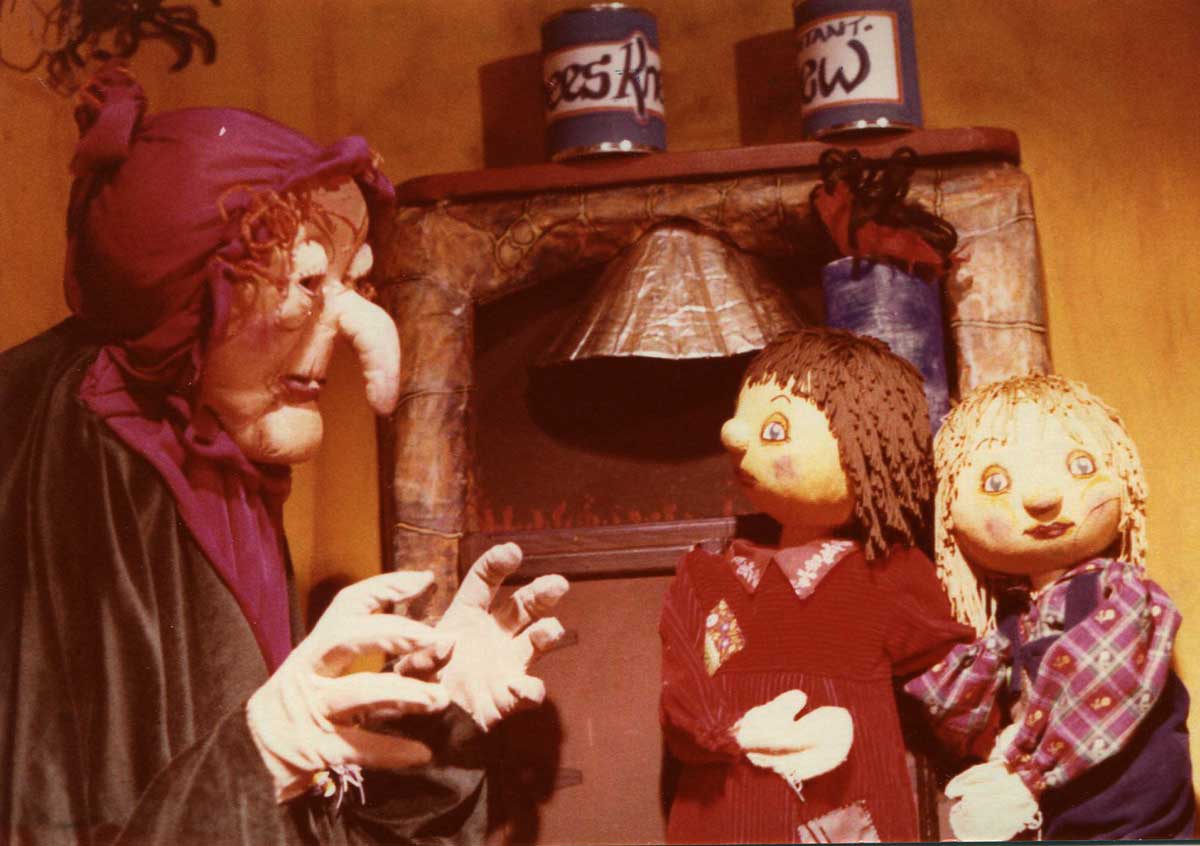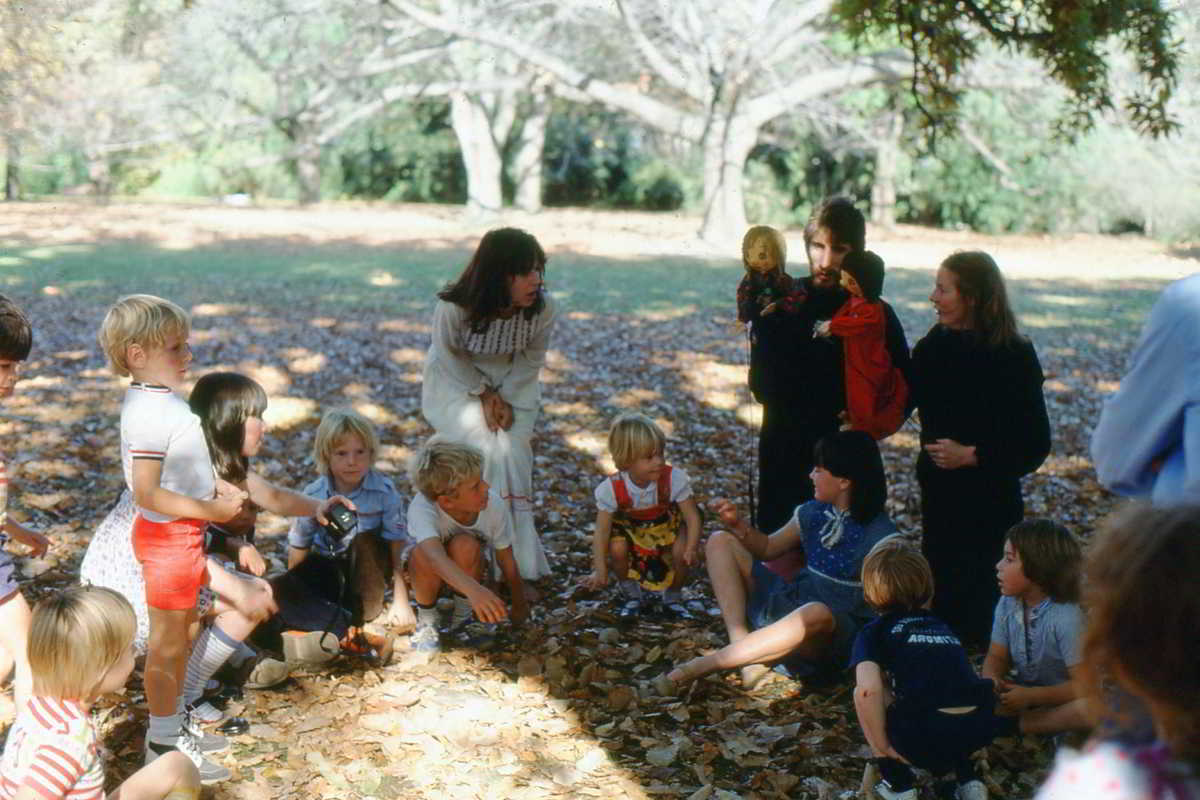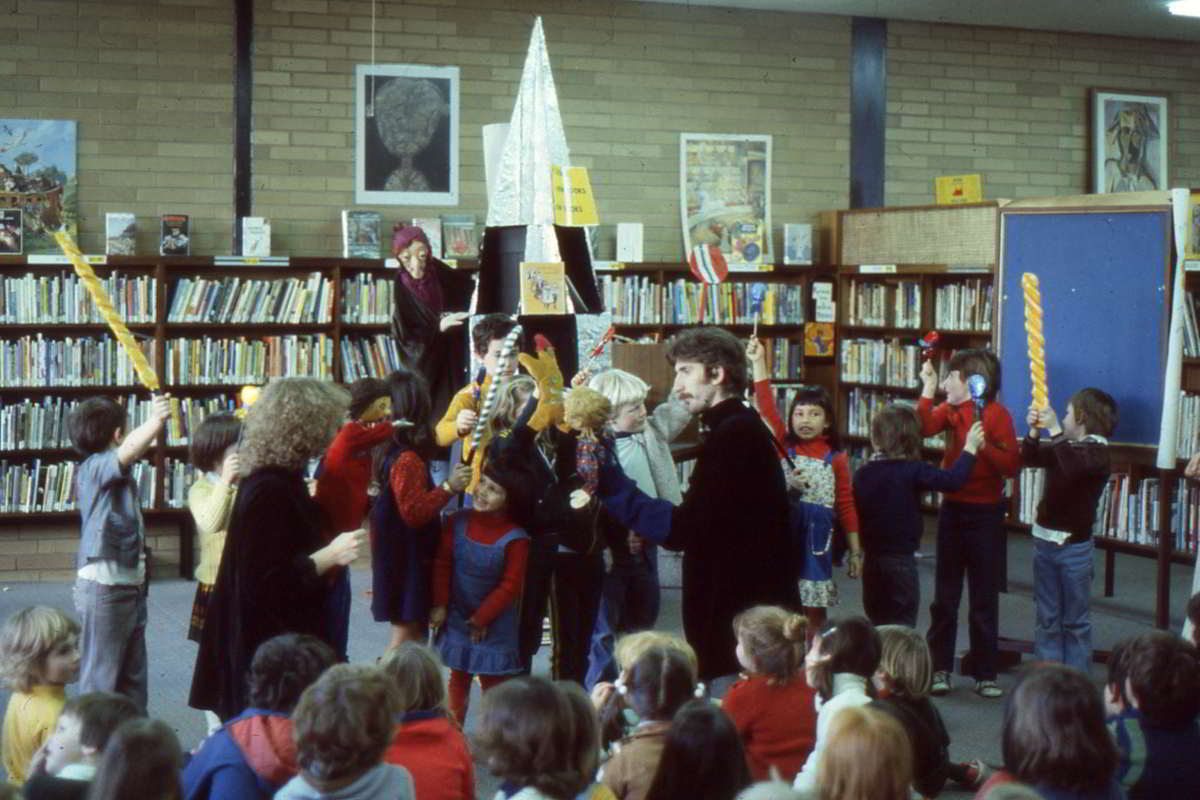| Premiere | Sunday 28 August 1977 |
| Venue | Anatol Restaurant & Reception Centre, Kew, Victora |

HANSEL AND GRETEL was Handspan Theatre's first production, created in response to a newspaper advertisement in The Age, Melbourne, calling for puppeteers to create a show for Sunday lunchtime performance in a family restaurant.
Handspan founders Ken Evans, Andrew Hansen, Helen Rickards, Peter J.Wilson, Christine Woodcock and Maeve Vella - all working together at the time for the Parry-Marshall Puppet Theatre - responded individually to the ad, but realised it would be better to pitch for the job together. In signing up collectively to produce the work, they established and became Handspan Theatre.
A puppet show re-telling a traditional fairy tale, the story of Hansel and Gretel, was not the play they had been hoping to create, but it was what the restaurant wanted. So, the aspirations of the group to make a contemporary work in both content and style were somewhat curtailed. Nevertheless, within these constraints, the script and its approach to the story reflected contemporary concepts and its design explored the boundaries of traditional puppetry.
In the Booth
HANSEL AND GRETEL was commissioned by Herman van Wichen, proprietor of Anatol Family Restaurant, for weekend entertainment at the restaurant. It was seen as a bold new dining concept by local food critic:
Back in the 1940s, the late Arthur Calwell, then Minister for Immigration, told a group of journalists: 'The Europeans we are bringing to Australia will give us much of their way of life and we'll see plenty of this on our tables.' This great Australian was on the ball when we look back over the three decades and we, the diners, are all the richer for it. Only last Sunday I thought of the former Minister's wisdom when dining at Anatol Theatre Restaurant as our grandchildren sat back in amazement watching the puppet show Hansel and Gretel. The mastermind behind this latest restaurant venture is a charming, enthusiastic Dutchman, Herman van Wichen. Seeking something different to complement Sunday luncheons he hit upon a puppet show remembering from his youth how these miniature shows were so popular in Europe...and he's backed a winner.
The play re-told the original story, at least the sanitised 20th century version, where the lost children tricked the witch, pushed her into the oven, and escaped in the end to find their way home. In an acknowledgement to the era, Gretel’s character was written as a feminist role model and it was she who led the siblings’ revolt and curbed her brother’s anxiety.
The production was designed to explore and mix puppetry styles within a booth setting. Puppeteers wore black, including hoods, and worked on their knees below a 4’ x 6’ open booth to which scenery and lighting were attached, and above which puppets appeared. Setting, costumes and manipulation proved problematic for live sound so the play was performed to a soundtrack recorded with guest actors and members of Uncle Bobs Jug Band.
Hansel and Gretel were hand/rod puppets with swivel heads and working arms. Their wandering led them through a ballet of dancing flowers, where hand puppets Bird and Mouse fed their crumb trail to finger-puppet chicks. Night fell eerily and bats circled on long sprung rods. The forest darkened and the Gingerbread House was built in a black theatre light curtain. Inside, the Witch loomed large, a life-size head-and-hands puppet, who crashed round in a miniature box-set kitchen, where a marot teapot flew and plates bounced in their shelves. Hansel was caged, the Witch tricked by a wishbone on a stick, the oven doors flew open and the kids pushed. Then Dad arrived to take the adventurers home.
The season at Anatol’s ran for 4 months and when it concluded, van Wichen sent the company to a colleague’s restaurant, Dominic's in Mildura for a further week in January 1978.
The production was not, however, built to tour, and, a six-hander, was economically unviable. Moreover, being an in-the-booth venture, a traditional story and playing to pre-recorded sound, was a compromise to its creators’ hopes and dreams for the potential of puppet-based theatre. So, it was revised for ‘out of the booth’ performances thenceforth.
Out of the Booth
HANSEL AND GRETEL was revised in early 1978 for performances that could play anywhere – indoors or outside. Its re-development was influenced by prevalent drama-in-education philosophy, particularly Peter Slade’s Child Drama1
, UK and emerging Community Arts practice in Australia.
Handspan’s version of Hansel and Gretel is a very versatile and always popular show. It’s already done a season in Mildura. But Hansel and Gretel isn’t just a stage show. Handspan has been known to discard many of the 52 puppets for the show-dancing flowers, bats, fireflies and so on-to hold a special session in a park for a children’s party. The kids themselves played a great part in the play.
The work played to small audiences of up to 30 children who, guided by its Narrator, participated in the show as it played around and amongst them. They became the forest through which Hansel and Gretel wandered, and operated a collection of lollipop marots to form the Gingerbread House. They ran from the Witch themselves, and helped Hansel and Gretel to extricate themselves from her clutches.
The kids themselves played a great part in the play. They danced about, dropped leaves onto the sleeping Hansel and Gretel and made the gingerbread house. This was pretty much on a par with what Handspan really wants to do.
'We want to use puppetry to relate to community issues' explained Handspanner Kenneth Evans. 'And we aim to make puppetry something for everyone, not just the kids,' added Maeve Vella.
For Handspan, the revised HANSEL AND GRETEL was more satisfying than its precursor. It was not only innovative in style, but its interactivity fed Handspan artists’ appetite for making contemporary puppet theatre that was relevant and stimulating to young audiences. It was also versatile – Handspan could 'go anywhere, do anything', and did. The production proved popular, touring across metropolitan Melbourne into 1979, confirming and sustaining the emerging company.
Carringbush Library, Melbourne:
Gretel, Helen Rickards, Hansel, Ken Evans, The Witch, Roy McNeill
Footnote:
| In the Booth |
|---|
| Creative team | |
|---|---|
| Devised & realised | Ken Evans, Andrew Hansen, Helen Rickards, Maeve Vella, Peter J.Wilson & Christine Woodcock |
| Design | Ken Evans & Maeve Vella |
| Original music & recording | Uncle Bobs Jug Band |
| Voice over artists | Jackie Stolz, Maeve Vella (Gretel), Peter J.Wilson (Hansel) |
| Puppet makers | Ken Evans (Set), Andrew Hansen, Helen Rickards, Dorothy Rickards (Witch), Maeve Vella (Hansel & Gretel), Peter J.Wilson & Christine Woodcock (Bird & Bats). |
| Performers | |
|---|---|
| Hansel | Maeve Vella |
| Witch & various | Helen Rickards |
| Bird & various | Christine Woodcock |
| Various | Ken Evans, Andrew Hansen (1977), Peter Seaborn (1978) |
| Out of the Booth |
|---|
| Creative team | |
|---|---|
| Devised | Ken Evans, Helen Rickards, Maeve Vella, and Christine Woodcock |
| Performers | |
|---|---|
| Hansel | Ken Evans |
| Gretel | Helen Rickards |
| Witch & various | Christine Woodcock or Roy McNeill |
| Narrator | Maeve Vella |
| In the Booth |
|---|
| Seasons | |
|---|---|
| August – December 1977 | Anatol Restaurant & Reception Centre, Kew, Melbourne |
| January 1978 | Dominic’s Restaurant, Mildura |
| Out of the Booth |
|---|
| Tours | |
|---|---|
| 1978 | |
| Feb/March | Free Entertainment in Public Places (FEIP) |
| March-December | Kindergartens, libraries & birthday parties – Melbourne metropolitan areas |
| 1979 | |
| January - March | Free Entertainment in Public Places (FEIP) |
| April - June | Primary schools and kindergartens Melbourne metropolitan areas |
| August - December | Primary schools, kindergartens, holiday and community programs Melbourne metropolitan areas |
| Total performances | 30 (1979 only) |
| Total audience | 2201 (1979 only) |
For Young People:

